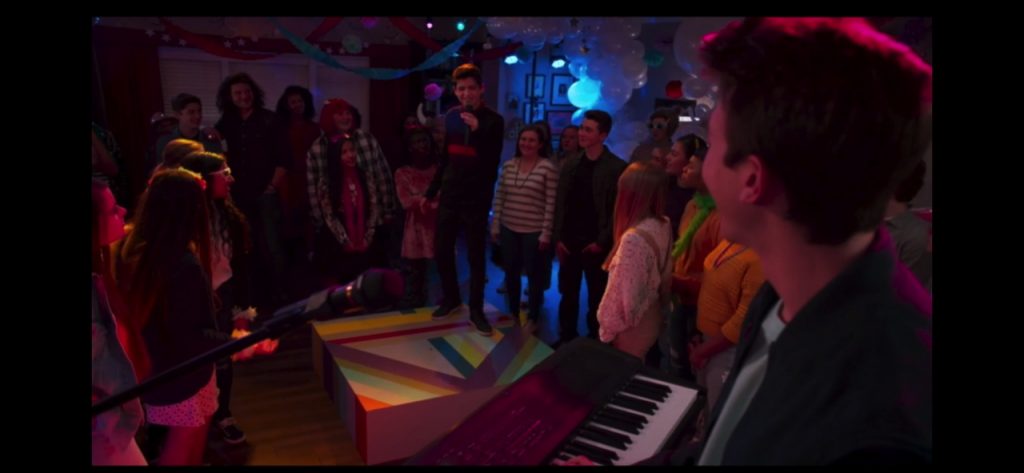
It was while digging into an unusual credit line in a 1964 exhibition checklist and trying to find research into why fandoms turn toxic that I ended up bouncing last week between a 220-page interview transcript with the late art historian Leo Steinberg and a postgame for #TyrusWeek, a recent fandom-wide effort to get the Disney Channel middle school soap opera Andi Mack trending on Tumblr during its final episode.
I saw a clip where the cast sings Lady Gaga’s “Born This Way” at a house party. There are dance platforms and no furniture at this house party. The dance platforms are painted in hard edge, multi-colored geometric and chevron patterns. They are odd because they are so intentional, and I am about to screenshot them and declare them works. Which is tedious–how do tumblr people even? –and so I switch, fatefully, to Leo Steinberg.
Steinberg’s interview is extraordinary, and I don’t care anymore about the minor detail that googled me to it. He talks not just in complete paragraphs, but in essays, complete with memorized quotes, Latin translations, and footnotes. [It would be easy to draw a connection between these browser tabs based on my own stanning for Steinberg–I met him on a fluke in like 1991 with Dominique de Menil, who brought him to Rice University for a series of Picasso lectures–but that’s not the point right now.] Whatever his controversy-generating research subject, from the seven [!] simultaneous interpretations of Christ’s hand positions in Leonardo’s Last Supper to the theological implications of paintings depicting or covering Christ’s genitalia, the recurring theme was a diffident defense of looking and grounding study in the work itself:
Columbia professor David Rosand once told me that undergraduates like my work, but that graduate students feel as if the ground were taken from under their feet. Here, they think, is a man who gets ideas just from looking at the pictures, instead of reading the literature.
…
Two years ago, I gave the Norton Lectures at Harvard under the general title, “The Mute Image and the Meddling Text.” It was not a plea for illiteracy, it was a plea to recognize that the work of art is the judge of the text. All too often I find art historians bringing in texts that are supposed to be explanatory, but they suppress nine tenths of what’s in the picture. Contradictory evidence from the image is discounted, because to have found the text, that’s what makes the enterprise art historical.
Steinberg taking issue with art historians’ prejudice for text resonates with fandom’s critique of headcanon, the wishful extrapolation/interpretation of fictional content beyond the actual canon, as defined by the content itself. And his style of close reading is not unknown among fans who study shows at the frame level and edit together clips and gifs. One tumblr poweruser, for example, imputed the convoluted path one student extra, Pink Backpack, had to have taken in order to appear in the backgrounds of a sequence of shots.
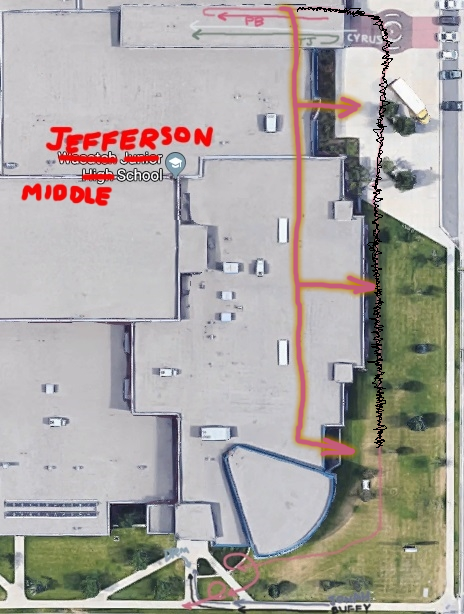
I realize I cannot do less than this with these dance platforms. I need to know more about how and why they are there. I found the episode, the last episode. I have questions.

The party was a wedding party for Andi’s parents? But the bride’s mother was not invited, and was not even supposed to be in town? And except for the bride and groom, the party guests are all children? The house is decorated like crazy. The mom/bride is DJ’ing. Cyrus is dancing like a carefree goofball. There are no dance platforms. The bride’s mom turns up and breaks it down in a glow-in-the-dark T-Rex costume and then disappears. There are still no dance platforms.
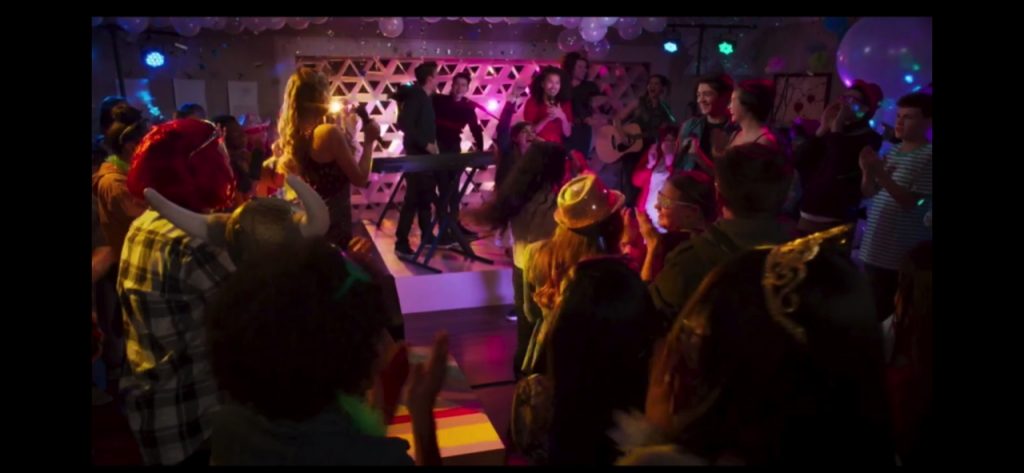
The scene cuts to TJ playing the opening chords of Gaga on keyboards on a large, rectangular platform. Two other square platforms are in front of it. The basecoat of all platforms is white. The large platform may be painted on the front edge. The square platforms are painted on top and visible sides. The room is full, but no one is on these platforms until Cyrus jumps on one to sing to TJ. Amber joins him. Mom/bride grabs a guitar and heads to the large platform, which is functionally a stage. Jonas and Andi jump on the other. Then Buffy jumps on TJ’s platform. Cyrus switches mid-song to join TJ. They sing what seems like the entire song.
Then all the ships come in: platonic Jandi (Jonas & Andi), Muffy (Marty & Buffy), and Tyrus (TJ & Cyrus).
Then everyone’s gone, and the mains are left talking by a fire pit, followed by multiple flashback scenes. Andi turns out to have applied and been accepted at an art high school that neither her friends nor parents knew she got into. She kept the news quiet for several days. [Early in the episode her parents were concerned about the thinness of her letter from the school, and hid it from her to avoid ruining the party.]
The principle of editing only accounts for part of the narrative and spatial discontinuities surrounding the dance platforms. Even if–especially if–the platforms were brought in during the party, which would have been rather disruptive, and not really necessary for dancing, given the rocking party already underway, why was no one dancing on them? Or was this performance space somewhere separate from the dancing spaces in the previous scenes?
Who painted them, and why? Presumably the same person or people who made the massive balloon arches and the origami light wall behind TJ. And who lives in the house. And filled her playhouse with origami cranes. And who is now canonically going to art school: The platforms are sculptures by Andi Mack.

Like the sculptures that inspired them, the “Untitled” (Go-Go Dancing Platform)s of Felix Gonzalez-Torres, they are default-empty and only activated when specific people mount them during brief musical performances that confirm them as objects of desire or attraction.
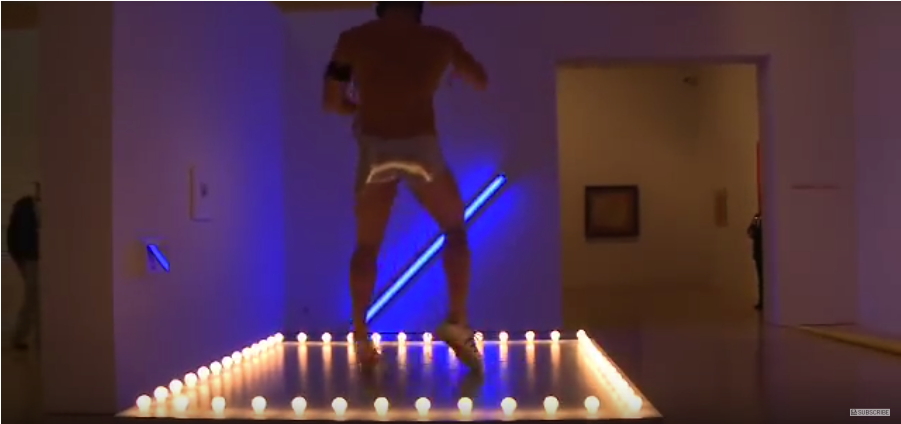
At this point I was ready to conclude that although Andi Mack was the author of the platforms, they could not actually exist as physical objects, and thus the “Born This Way” scene, and possibly the entire party, did not happen in the physical world. Were they dream sequences? Fantasies? Ayahuasca hallucinations around the fire pit? Did someone sneak pot brownies into the party? Did the fandom’s collective aura somehow coalesce and manifest as premium content? [If it’s that last one, watch for Disney to patent the crap out of it before the VHS tape even finished rewinding.]
But then I discovered Pink Backpack, and realized what fans already knew: that the world of Andi Mack only maps imperfectly onto what we call the real world–or for that matter, Google’s own simulacrum of it. Andi Mack fans not only recognize what Robert Rauschenberg called the gap between art and life, they explore and create in it. Now I understand these objects, which I have called Untitled (Gaga Dancing Platforms), are decorated props for a specifically aestheticized TV show which until recently aired on the Disney Channel.
LMAO 30 MINUTES LATER UPDATE: OK, fronting got me this far, and I was still sure people who have actually watched Andi Mack would come for my clownish naiveté if they didn’t just ignore me altogether. But I never thought I’d get sideswiped by pretending I’d heard of Lady Gaga’s “Born This Way,” much less heard it, before finding this clip. And only after posting this did I go and watch her actual video. Which, I HAVE SOME QUESTIONS.
They censored the hell out of that song for the Disney Channel, and it still seemed like the gayest possible anthem those kids could have sung to each other.
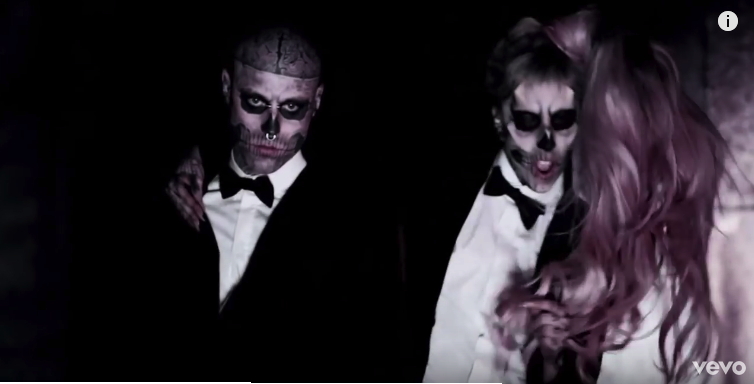
The video features Rick Genest, aka Zombie Boy [above, left], the heavily tattooed artist/model/whatever who was also a character/subject/whatever in one of the wildest pieces of art writing in existence: Hounds of Love, a poolside dialogue at the Chateau Marmont about Sturtevant’s 1995 work, Gonzalez-Torres Untitled Go-Go Dancing Platform [below], in Bruce Hainley’s Under the Sign of [sic]: Sturtevant’s Volte-Face. I had been so intent on leaving Sturtevant out of this and just sticking to the text [sic] of the work, and yet here she is at the center of it all along. I am shook, Andi Mack, I am shook.

Also now I think Mack Untitled (Gaga Dancing Platform) will, in fact, be a thing.
[week later update: Notes on Untitled (Gaga Dancing Platform) ]
Bruce Hainley talking to Andrew Durbin about Under the Sign of [sic] [larb]
Buy Under the Sign of [sic]: Sturtevant’s Volte-Face [amazon bookshop.org]
Previously, related: Leo Steinberg on Erased de Kooning Drawing
